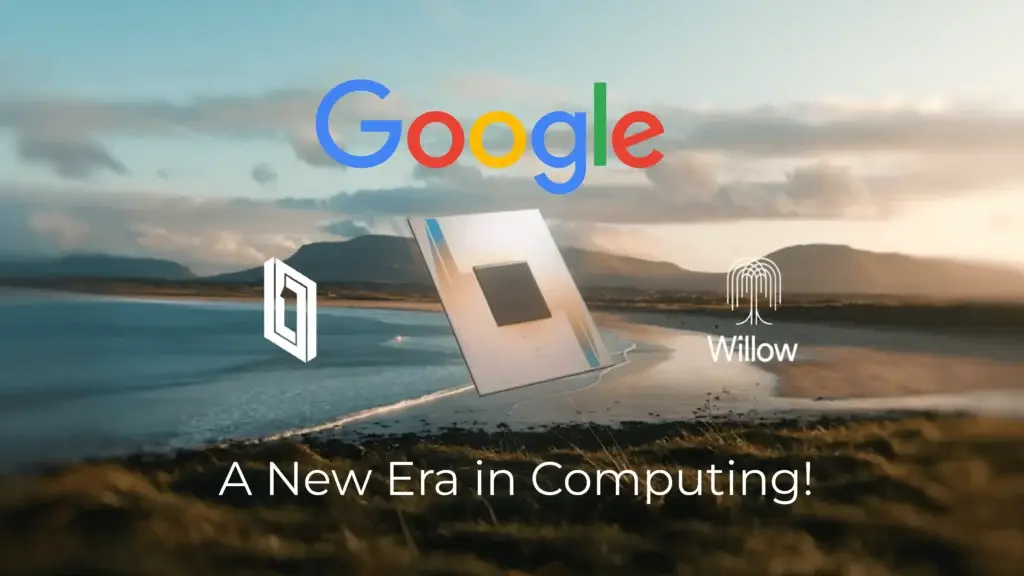
Google's Quantum Leap in Computing
Google’s Willow quantum device represents a big step forward in the advancement of quantum computing. It builds on the company’s prior work with the Sycamore processor, which famously established quantum supremacy in 2019 by solving a problem quicker than the world’s most powerful classical supercomputer. It intends to advance quantum computing by addressing some of the field’s most pressing difficulties, such as qubit coherence, error correction, and scalability, and it promises to spur innovation in a variety of industries.
A Closer Look at Google’s Quantum Chip
Willow is a superconducting, qubit-based processor created as part of Google’s Quantum AI effort. This effort focuses on applying quantum computing to issues that traditional systems now struggle with, such as cryptography, optimization, and drug development. The chip extends the work done with Sycamore, but it is intended to tackle larger, more complicated problems with more precision and efficiency. While Sycamore proved quantum dominance in a narrow activity, It aims to find practical applications for quantum technology across other areas.
Superconducting Qubits: The Core of Willow’s Innovation
Willow makes use of superconducting qubits, which are quantum bits that work in superposition. Superconducting qubits have become a cornerstone of quantum computing because of their ability to store and process information in ways that classical bits cannot. However, one of the key issues is maintaining qubit stability, which is extremely sensitive to external perturbations. Its architecture focuses on enhancing qubit coherence. This improves the stability of the quantum device and allows it to execute more complex jobs.
Scalability and Error Correction: Overcoming Quantum Computing's Biggest Hurdles
One of Willow’s distinguishing traits is its scalability. While many early quantum computers were limited in the number of qubits they could properly manage, its architecture is intended to scale up while maintaining operational reliability. This is accomplished by incorporating advanced error correction techniques, which help solve the high error rates common in quantum systems.
Qubits are highly susceptible to noise and interference; hence, quantum error correction is critical for maintaining the precision of quantum computations. By including error-correcting codes into its design, Google ensures that the device can run efficiently for longer periods of time, bringing it closer to real-world applications.
Harnessing Quantum Algorithms for AI and Machine Learning
Quantum computing has the potential to transform AI and machine learning, and Willow is no different. Quantum machine learning techniques use quantum processors to process large datasets and execute complex calculations faster than traditional computers. Its ability to accelerate AI model training could drive innovation in industries such as healthcare, automotive, and logistics.
For example, training deep neural networks frequently necessitates dealing with huge datasets. Traditional systems can take weeks to handle such data, but Its quantum capabilities could dramatically shorten this time, boosting advances in industries such as drug development and driverless vehicles.
Real-World Applications
Willow has a wide range of potential applications. In drug discovery, quantum computers can better model molecular interactions than regular systems, allowing researchers to create new drugs more effectively. In material research, quantum simulations may lead to the discovery of novel materials with uses in electronics, energy storage, and other fields.
It could assist in understanding the complex relationships inside global climate systems, resulting in more accurate predictions and remedies to climate change. Additionally, quantum computing has the potential to optimize supply chains and logistics, making operations more effective by evaluating massive datasets and identifying optimal solutions in real-time.
The Future of Quantum Computing: What's Next for Willow?
Despite Willow’s impressive achievement, there are still many obstacles left in quantum computing. Maintaining qubit coherence over long periods of time is one of the most difficult challenges. To be helpful in real-world applications, quantum computers must be able to process information consistently and error-free. Google’s efforts to improve error correction and develop quantum algorithms are critical to overcome these obstacles.
Another problem is scaling quantum systems. While it is a significant step in this regard, the quantum computing community must develop systems capable of managing millions of qubits. Scalability is vital for realizing the full promise of quantum computing.
Looking Toward the Future
Willow, developed by Google, is part of a bigger vision for the future of computing. Willow’s further evolution is likely to pave the path for more powerful quantum processors capable of solving challenges previously believed unattainable for classical systems. The combination of enhanced quantum algorithms, error correction, and scalable hardware will enable the widespread deployment of quantum computing, making it a revolutionary force in industries such as AI, healthcare, and climate research.
Conclusion
Google’s Willow quantum device represents a significant advancement in quantum computing, providing a glimpse into the future of addressing complex global concerns. Willow advances the use of quantum technology in real-world applications by enhancing qubit stability, scaling quantum systems, and incorporating quantum error correction. As this technology evolves, it is likely to have a significant impact on sectors around the world, providing innovative answers to issues that traditional computing could never solve. Willow is only one step along a long path, but its importance cannot be emphasized.
For more information on the scientific development and potential ramifications of quantum computing, visit materials from top technology sites such as Technology Magazine. Read more at Home of Technology News
Click on the link to understand more about Future of Computing
